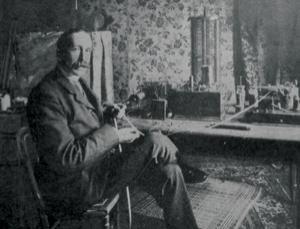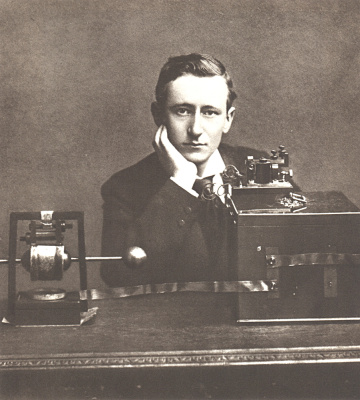Paul VK2ICQ adds:
Thanks to Stuart VK2FSTU for the link. Note that we’ve previously posted a video on this exact event by Tom Scott, if you missed it first time around and you’d prefer to watch rather than read, here it is again!
From Hackaday, written by Richard Baguley, original post here.
The place is the historic lecture theater of the Royal Institution in London. The date is the 4th of June 1903, and the inventor, Guglielmo Marconi, is about to demonstrate his new wireless system, which he claims can securely send messages over a long distance, without interference by tuning the signal.
The inventor himself was over 300 miles away in Cornwall, preparing to send the messages to his colleague Professor Fleming in the theater. Towards the end of Professor Flemings lecture, the receiver sparks into life, and the morse code printer started printing out one word repeatedly: “Rats”. It then spelled out an insulting limerick: “There was a young man from Italy, who diddled the public quite prettily”. Marconi’s supposedly secure system had been hacked.

The person behind this hack was Nevil Maskelyne, an inventor, magician, and general troublemaker who was a long-time rival of Marconi. He was the manager of a rival wireless company and had been involved in a number of disputes with Marconi over the patents that covered wireless telegraphy systems. He decided that the most effective way to show that Marconi’s claims were hollow was a practical demonstration.
In the trade journal The Electrician (the Hackaday of its time) he detailed how he hacked the system. One of the fundamental claims of Marconi was that because his system used a tuned signal, other signals would not interfere unless they were tuned to the same frequency. This, however, had not been proven to the satisfaction of Maskelyne, and he didn’t accept that the system was really secure. So, he set out to demonstrate this. But how could you prove this? In his account in The Electrican, he wrote that:
“When, however, it was pointed out to me that the practical demonstrations accompanying the lecture rendered independent tests possible, I at once grasped the fact that the opportunity was too good to be missed… The only hope, then, was to interpolate messages calculated to anger and “draw” somebody at the receiving end. If that could be done, there would be proof positive.”

His plan involved setting up a transmitter not far from the lecture (supposedly in the theater that his father, a famous stage magician, owned) that would overwhelm the signals from Cornwall. His transmitter, he claimed, was not run at full power: while it was capable of outputting 8 or 9 Amps, he turned it down to 2.5 Amps. He didn’t simply block the signal, but instead transmitted his own morse signal for a short time, claiming that he “studiously refrained from all unnecessary interference”.
His plan worked. Towards the end of the lecture, Maskelyne’s signals were picked up by the receiver, decoded and noted by Fleming, who wrote to the Times complaining of “Scientific Hooliganism”. A slew of letters to and fro in the Times followed, where Maskelyne and Fleming argued over if the interference was caused by Maskelyne or other phenomena, such as ground loops or the electrical lighting in the theater.
In the end, it was discovered that the receiver that Fleming had been using was not, in the phrasing of the time, syntonic. It wasn’t tuned to a specific frequency, excluding all others, because a syntonic receiver would have been too large to use in the demo. In effect, Marconi was being at least a little deceptive. Maskelyne ended his account with the latin phrase “Qui vult decipi, decipatur”, a legal phrase that translates as “Let him be deceived who wishes to be deceived.”
In the end, the hack did little to dent Marconi’s reputation. Just the year before, he had sent the first wireless signal across the Atlantic and started a commercial transatlantic service a few years later in 1907. That same year he was awarded the Nobel Prize with Karl Ferdinand Braun “in recognition of their contributions to the development of wireless telegraphy”. When he died in 1937, the BBC observed two minutes of silence in respect, and asked all radio transmitters to do the same.
What the hack did, however, was to reframe the discussion on wireless security. Rather than accept Marconi’s assertion that these signals were secure and could not be interfered with, researchers afterward started looking into ways that these could be monitored, jammed and otherwise manipulated. The ease with which Maskelyne could monitor the signals was also an eye-opener for governments and lead to the development of wireless encryption systems that were used in World War I, II and beyond.
Nevil Maskelyne died in 1924, and is best known for his other career as a magician. He wrote “Our Magic: the art in magic, the theory in magic, the practice in magic”, a magic textbook that is still in use. His son Jasper Maskelyne applied these magical skills in World War II, where he was involved in the development of the fake munitions, tanks, and other trickery that helped mislead the Nazis in the lead up to D-Day, and taught soldiers how to hide escape tools in everyday items.
If you want to read more about this fascinating period in the history of technology, Thunderstruck by Erik Larsen is a great place to start. It details the history of radio by discussing the life of Marconi and how his invention helped to catch the notorious murderer, Dr Crippen.
